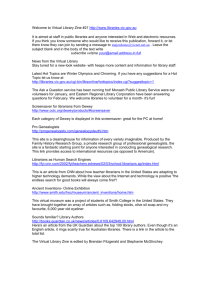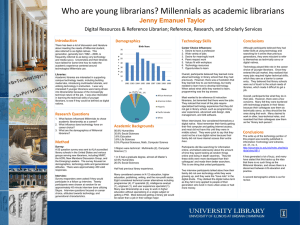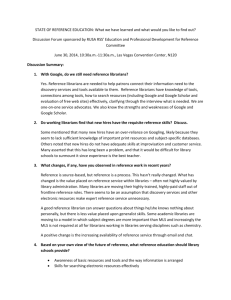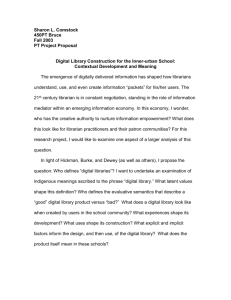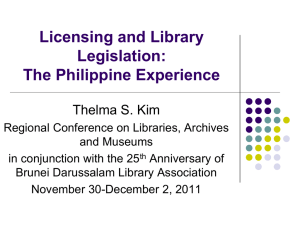The Future of Librarianship
advertisement
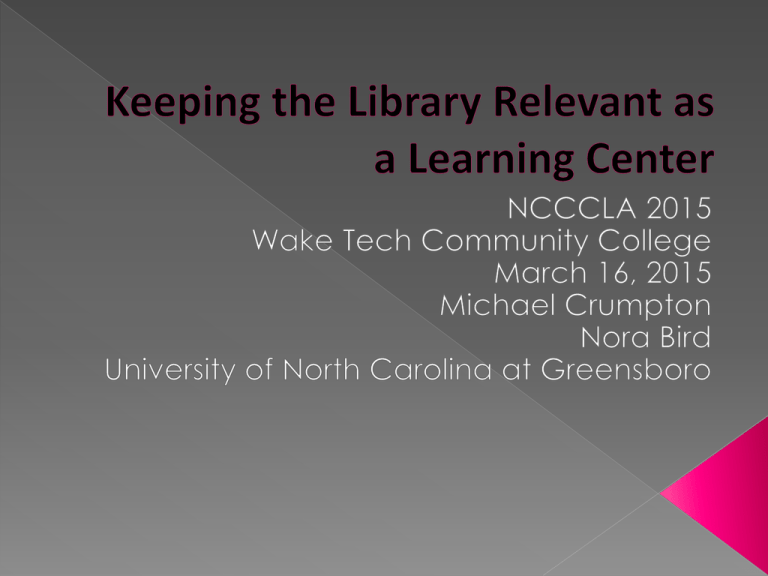
The Process of Becoming Different To Transform or Convert A Transformation or Modification; Alteration Alternative higher education choices Shifting staff ACRL Information Literacy Framework Transition to Openness Digital education Ebooks Student data Leadership Can an academic library properly demonstrate return on investment? Lib-value project Future of the library task force › Focus on literacy › Fundraising › Volunteers › Measure impact Programming that promotes and transforms student learning Libraries create, are special, not testing centers or supreme authority Demonstrating conversations with community and value gained Focus on knowledge Tell stories of impact with students and community Gatekeeper of culture Facilitating conversations that foster knowledge construction Seth’s Blog: The Future of the Library Seth’s proposal for economic shortfalls: “train people to take intellectual initiative” to find and connect to information already out there Keep the machines in your factory but change what they make Keep your customers but change what you sell Keep your staff but change what you do Keep your mission but change your scale Keep your technology but use it to do something different From “Change the Culture, Change the Game”, Connors & Smith › Leaders must create needed culture Must have a direction/goals › It’s the culture that produces the results If the culture doesn’t change nothing will › Accountability is the key At multiple levels Print vs. electronic › Who manages? Issues › Who is engaged? Administrators vs. faculty › Costs vs. format of use How to resolve › Who advocates for what? Growing pains Information overload › Who to manage and curate? Administrative vs. faculty (POV) Leadership perspective From Assessment in Action Projects › Student confidence in research activities › Contributes to retention and persistence › Library instruction connected to higher grades › Space fosters social and community academic works and activities › Games/programming engage students and learning of IL skills Service learning › Validation and motivation (confidence) › Hands-on learning (practice) › Career preparation Information literacy component › Adds how and whys › Helps explore research potiential Be Nimble Be adaptable Know the values Have a plan Communicate Be visible Be transparent Be positive An ACRL e-Learning Online Course April 13-May 15, 2015 Description: This five week course offers 1.5 hours each week on topics of interest to new and experienced community college librarians. The topics covered will be: Advocating for Your Library - Advocacy is often talked about as a political activity but it really means connecting with all constituents including faculty, staff, and students. The importance of relationship building through implementing a comprehensive advocacy plan will be discussed. Assessment of Library Activities - One major part of successful advocacy is to be able to show how faculty, staff, and students are using the library. Types of assessment will be described and attendees will be asked to choose one or two that might be implemented in their own library. Embedded librarianship - There is a wide range of services that have been labeled with this heading. The presenters will cover how this service has been implemented in several libraries and ask the attendees to design a possible service for their situation. Instructional design - Many librarians were not taught how to teach. The presenters will cover general instructional design theory and attendees will try to revamp a particular class that they teach. Supervision - Many first-time librarians are asked to supervise immediately when taking a position in a community college. Strategies for becoming a successful supervisor will be covered in this part of the course. The presenters are the co-authors of Handbook for Community College Librarians, published in 2013 and experienced community college librarians. Learning Outcomes: Understand and value the unique and diverse mission of community college librarians in support of their institutions goals. Design programs that fit an individual community college in the areas of instruction and embedded librarianship. Implement strategies for better employee supervision and efficiencies. Burnes, Bernard, and Philip Jackson. "Success and Failure in Organizational Change: an Exploration of the Role of Values." Journal of Change Management 11.2 (2011): 133-162. Web. Connors, Roger, and Tom Smith. Change the Culture, Change the Game. New York: Portfolio/Penguin, 2011. Print. Godin, Seth. "The Future of the Library." Seth's Blog. N.p., 16 May 2011. Web. 18 May 2011. <http://sethgodin.typepad.com/seths_blog/2011/05/the-future-of-thelibrary.html>. Hamilton, Buffy J. "Pivots for Change: Libraries and Librarians." Library Media Connection. Linworth Publishing, May & June 2010. Web. Lankes, R. D. The Atlas of New Librarianship. Cambridge, MA: MIT Press, 2011. Print. Lankes, R. D. Expect More: Demanding Better Libraries for Today’s Complex World. www.DavidLankes.org, 2012. Print. McKnight, Michelynn. The Agile Librarian's Guide to Thriving in Any Institution. Santa Barbara, CA: Libraries Unlimited, 2009. Print. http://www.oclc.org/research/events/2011-06-08.htm "Adaptability: the New Competitive Advantage." Harvard Business Review. Harvard Business Publishing, July & Aug. 2011. Web.

